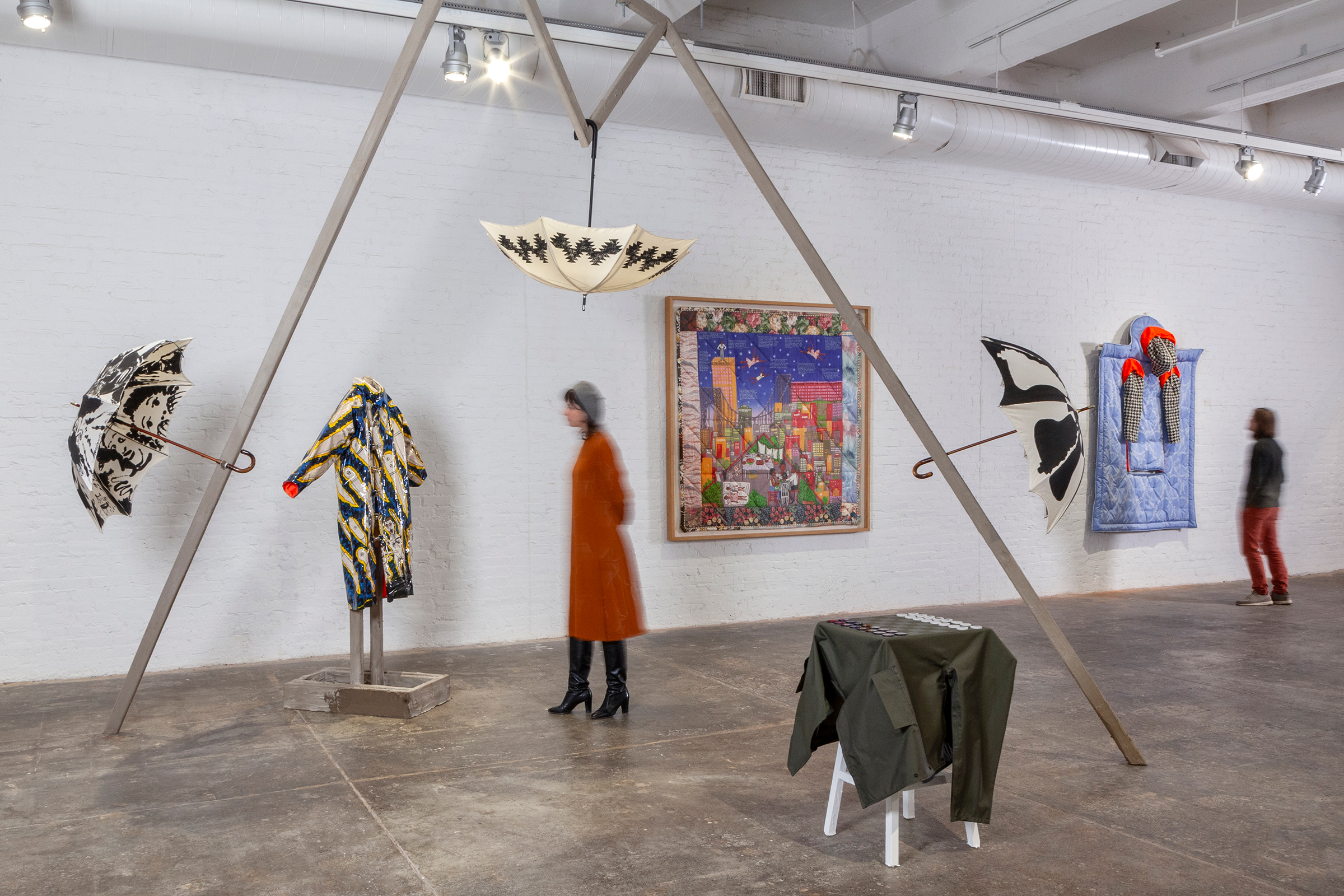The Show Debuts New Commissions by Eight Artists Alongside FWM’s Collection
Press Event: Thursday, December 12, 2024, 10:00 am–12:00 pm
Philadelphia, PA, November 20, 2024 —The Fabric Workshop and Museum (FWM) is pleased to present Soft/Cover, a major exhibition spanning three galleries on view now through August 17, 2025. Soft/Cover surveys the many surprising ways artists have used fabric and screenprinting to create objects that relate to the body. Focusing on the connection between textiles, fashion, and architecture, the exhibition includes new and rarely-shown works from The Fabric Workshop and Museum’s collection—each created by Artists-in-Residence in collaboration with FWM’s Studio team.
Founded in 1977, FWM has dedicated nearly five decades to helping artists experiment, often introducing them to textiles and the process of silkscreen on fabric. This creative journey has historically been known to change the direction of an artist’s practice by emphasizing new materials and techniques.
Soft/Cover draws inspiration from some of the Workshop’s earliest residencies in the late 1970s and early 1980s. During its first decade, celebrated artists such as Richard Tuttle, Lynda Benglis, Roy Lichtenstein, Vito Acconci, Louise Nevelson, and many others benefited from intensive three-week opportunities to explore the possibilities of screenprinting. Artists-in-Residence have created wearable objects from everyday workwear to costumes, suits, dresses, and pants. While their works primarily focused on the body, these artists also expanded beyond garments to design upholstery, bedding, umbrellas, furniture, room dividers, large-scale installations, and shelters.
Seven artists were invited to work in residence with the FWM Studio to develop new works for this exhibition: Mildred Beltré Martinez (b. 1969), Julia Chiang (b. 1978), Brendan Fernandes (b. 1979), John Killacky (b. 1952), Aimee Koran (b. 1982), Borna Sammak (b. 1986), and Armando Veve (b. 1988). Milan-based artist Jenny Walton (b. 1990) was also commissioned to contribute new works in conversation with FWM’s collection. This new cohort has created new garments, yardage, furniture, shelters, and more. True to the Workshop’s history, the residencies have opened pathways for these artists’ ideas, introducing new materials and forms to their ever-evolving practices.
DJ Hellerman, FWM’s former Chief Curator and Director of Curatorial Affairs, who conceived and co-curated the exhibition with Katy Donoghue, Editor-in-Chief at Whitewall Magazine, said “This deep dive into FWM’s collection has been a great adventure and has allowed us to show the tangible and expansive ways the Workshop has delivered on its mission and ethos from 1977 through today. Katy and I set out to answer the question, ‘What happens when artists bring imaginative thinking to fashion, garments, and objects that relate to the body in space?’ The results are wildly experimental. I don’t expect audiences will have experienced a textile show like this before.”
Visitors will encounter wearables such as shirts, boxers, capes, uniforms, swimwear, and jumpsuits displayed on concrete-coated armatures that jut into space and crisscross the gallery. The curators’ dynamic display seeks to create the opportunity for viewers to experience garments in the round while attempting to avoid the use of traditional mannequins, plinths, or pedestals.
“Performance certainly plays a role in how we understand works that imply activation by the body,” said co-curator Katy Donoghue. “Beyond costumes, these artists are exploring the performance of everyday life. We had to ask ourselves, ‘How can we convey performance when the body is removed?’ We envisioned a deconstructed department store arranged in a way that leads your eye around the dimensions of a piece. We hope it sparks curiosity and conversation.”
Featuring some of the earliest works created with the FWM Studio, Soft/Cover traces the throughlines of material, formal, and conceptual experimentation during the Workshop’s formative years through today. Rarely shown early works include Judith Shea’s Vests (1977), Kim MacConnel’s Bamboo Curtain (1978), Jody Pinto’s Hair Shirt (1978), Isaiah Zagar’s Self-Portrait Poncho (1979), Marcy Hermansader’s Highway Cape (1979), and Alexa Kleinbard’s Sorceress’ Cape (1979). Other garments by artists such as Richard Tuttle, Claire Zeisler, Lynda Benglis, Luis Cruz Azaceta, Jun Kaneko, Marjorie Strider, and Jonathan Lyndon Chase showcase an array of printed patterns realized across decades of design thinking.
Transitional works such as Louise Nevelson’s Opera Costume (1985), Ecke Bonk’s Chess Jacket (Checkett) (1987–1991), Chris Burden’s L.A.P.D. Uniform (1993), and Hella Jongerius’s Mobile Dreaming sleeping bag (2001) blur the line between sculpture and wearable art. Folding screens from Carrie Mae Weems and Pat Steir as well as mobile shelters from Robert Kushner and Bob Bingham move fabric into the realm of architecture. Another highlight, Robert Morris’s bed set, Restless Sleepers/Atomic Shroud (1981) warns of nuclear destruction through the haunting absence of the body.
New Commissions
Mildred Beltré Martinez
Without Is As Within, 2024
Built upon grassroots organizing and political thought, Mildred Beltré Martinez’s creative practice comprises an expanded field of printmaking, drawing, and sculpture. She draws upon the work of writers that deploy imagination as a political tool to inform our experience. Mirroring an ethnic and gendered experience of living in the United States, Beltré Martinez creates work that is warm, funny, difficult at times, and part of a larger tradition of Black and Latinx activist art.
Without Is As Within brings together Beltré Martinez’s interest in prefigurative political imagination (an approach to political action in which activists model the social relationships they seek to achieve more broadly) in addition to notions of family, memory, loss, and protection. Both custom yardages used to construct this work were based on a photograph of furniture, specifically a sofa and a recliner that were anchors of Beltré Martinez’s memories of her grandparents.
Conceived and produced during the summer when Beltré Martinez’s twin children were preparing to leave their family home to attend college, Without Is As Within is a complex representation of a family in transition: a parent’s self-aware desire to remain close, support growth, and provide shelter and protection, while grappling with the loss that accompanies changing family dynamics. With stools arranged under a roof-like structure, Beltré Martinez creates the possibility for intimate connections.
Julia Chiang
Going Under, Shhh, 2024
Julia Chiang considers the body to be central to the allegories, metaphors, and exploration she builds around her work. Her abstract paintings and ceramic objects often use organic forms and repeated patterns to represent introspections ranging from the corporeal to the psychological.
To make yardage for Going Under, Shhh with FWM’s Studio team, Chiang created a rich print of layered forms that collide, overlap, and intertwine. Waves of her signature teardrop patterns sweep over wisps of dotted constellations in blue, green, and pearl. Drawing upon the experiences and feelings of secret havens, dreams, survival, protection, practicality, and joy, Chiang offers a space for visitors to reorient themselves by presenting the work overhead as a long, flowing canopy.
“The feeling of no choice but to make, I think, is something most artists relate to,” says Chiang. “I am thinking about how what we do can have a purpose beyond where it normally lives. In a way, this opportunity to make textiles and prints is a way to imagine how my work might offer more. A private pause within a space, imagining the ability to offer shelter, protection, or…escape.”
Brendan Fernandes
In Two, 2024
Soft Touch I, 2024
Soft Touch II, 2024
Commissioned by the Pulitzer Arts Foundation, dance composer and visual artist Brendan Fernandes worked in collaboration with FWM’s Studio team to create an installation of curtains and soft sculptures to accompany an exhibition of the artist Scott Burton’s (1939–1989) work. In a new series of duets titled In Two, Fernandes has written dance scores that take Burton’s furniture sculptures as a point of departure to explore the duality of display and concealment in gay cruising culture—ideas that Burton had pursued throughout his career. Fernandes integrates specific gestures—“flip the wrist,” “clasp arm to the breast”—directly from Burton’s choreographic notes.
Taking inspiration from Window Curtains, a work in FWM’s collection that Burton created during his own FWM residency in 1978, Fernandes worked with the FWM Studio to create a new set of curtains that would be activated by his choreographed performances. Screenprinted on cotton muslin, the curtains feature flesh, steel gray, and blush-colored fingerprints left on a phone screen. For the artist, these smudges are suggestive of texting or swiping left or right in dating apps—a digital form of cruising.
Soft Touch I and Soft Touch II, a pair of soft sculptures designed by Fernandes to resemble polished stone, complement and contrast with Burton’s hard materials. Using images of actual Burton benches, the FWM Studio team created the surface of these stuffed artworks through a digital printing process on cotton canvas. Fernandes intends for dancers to use the curtains and soft sculptures as props during choreographed performances of In Two.
John Killacky
stillpoint, 2024
John Killacky is an artist, filmmaker, arts administrator, and politician whose work explores the challenges of navigating the world in a disabled body. In 1996, Killacky had surgery to remove a tumor from his spinal cord and initially woke from the procedure a quadriplegic. With intensive rehab, today he is paraplegic with lingering neuropathic pain. Adding to his condition, an accidental fall in 2021 resulted in a fractured fibula. Since then, Killacky has been living with intense chronic pain. After exploring various treatments (Reiki, acupuncture, and other body work), Killacky started to understand his pain in terms of managing energy fields.
Killacky explains, “My body is not balanced. My brain doesn’t know I have a left leg and I have no sensation in my right leg. During one of my treatments, suddenly I felt my body in balance—with energy surging into my dormant left side. The therapist said it’s called the ‘stillpoint.’ It’s very elusive. If you’re a meditator, it is the point when your body becomes fluid. Ever since that moment, I knew I wanted to do a piece about the liminality of stillpoint, grasping for equilibrium.”
During his collaboration with the FWM Studio, Killacky created fragments of a burial shroud, a body’s final soft covering before decomposition. Using treated latex as an unstable medium, Killacky intends for the pieces to appear tattered as unearthed, decaying relics. On one leathery shroud, a subdued self-portrait painting burned ever-so-faintly offers a latent reveal of the artist’s likeness. On the other shroud, Killacky projects a video exploring his condition and quest for stillpoint. To accompany these works, Killacky had four statements from the video stenciled onto strips of burlap, sewn together, and displayed on the floor in a nearby corner. Collectively, they serve as guidance for coping with trauma in the body.
Aimee Koran
MSS, 2024
Aimee Koran’s practice is centered around the idea of invisible labor, specific to mothers, pregnancy, and birth. Her multidisciplinary practice manipulates and elevates the everyday objects and materials of motherhood to help us see them anew. Breast pumps are chrome-plated in bright colors, fertility sticks come together to create mesmerizing patterns, stuffed animals are torn apart and rebuilt inside out, and breast milk is spilled and magnified to create celestial, otherworldly landscapes.
For her time at the Workshop, Koran knew she wanted to work with her Milkscapes series, which she has described as a visual reference to outer space. Originally created after an accidental spill of her own breastmilk, she imagined transforming its imagery into a space suit, likening the experience of approaching motherhood to the mission of an astronaut traveling to new, unknown territory.
In working with the FWM Studio team, Koran’s design evolved into a practical boiler suit with compartments for essentials like baby wipes, flaps and cinches for breastfeeding access, and more. Recognizing motherhood as a form of unprotected labor and essential to the care economy, the artist also created a series of patches that play on labor union and NASA patches—the former inspired by one belonging to her grandmother. MSS (an acronym for Mama Space Suit) positions the work of motherhood as vital, brave, and worthy of our reverence.
Borna Sammak
Head Giving Jacket, 2024
Borna Sammak’s artistic journey began as a high school apprentice at The Fabric Workshop and Museum. He frequently draws inspiration from his everyday urban surroundings as well as film, television, YouTube, and digital advertising. Spanning a range of media—including installation, videos, and wall-pieces—his works reconfigure mundane objects, texts, signs, slogans, clothes, or cartoons into compressed metaphors and dense patterns. Through these acts of combination and juxtaposition, the artist embraces humor, awkward moments, and occasional feelings of dread.
Sammak’s jacket, created specifically for Soft/Cover, gives form to a digital collage that combines and rearranges three found wallpaper patterns. In partnership with FWM’s Studio team, Sammak designed and printed yardage that incorporates bamboo stalks, animal-head canes, and an art-deco swirl. The print’s bright colors and simplified forms draw inspiration from one of the artist’s long-time favorite jackets, a vintage Michigan Rag Co. Fish Hooded Jacket. Sammak’s bespoke oversized hoodie embodies personal comfort in everyday wear.
Armando Veve
Millions of Cats, 2024
Armando Veve is an artist recognized for his incredibly detailed illustrations of imaginative and surrealistic scenes. The beautiful and the absurd blend into uncanny depictions of wondrous worlds that fuse everything from flora and machinery to sea creatures and contemporary technology. Veve’s diagrammatic compositions offer a journey full of juxtapositions and discoveries that delight and disquiet in equal measure.
Veve’s Millions of Cats takes inspiration from the celebrated children’s book of the same name, written and illustrated by Wanda Gág, published in 1928 and widely recognized as the first modern picture book. For Veve’s monumental tapestry, he references the preposterous part of the story when the millions of cats fight to the death over which is the prettiest. The artist depicts his cats in a violent, vivid reverie that references Rodin’s Gates of Hell and Picasso’s Guernica. Veve’s metamorphic cats—emoting greed, lust, disgust, gluttony, sadness, loneliness, and euphoria—jostle within a labyrinthine composition that illuminates the creation and destruction that shape our lives.
Transformed into yardage with the FWM Studio team, Veve’s Millions of Cats is printed in red, yellow, and black to reference the original colors of Gág’s classic children’s book. Veve invites the viewer to get lost in his expansive four-way pattern that tells the story anew. The grand tapestry is made complete with custom-made feline finials, making sure, as with all Veve’s work, that no detail is overlooked.
Jenny Walton
I CAN’T BELIEVE IT I FORGOT TO HAVE CHILDREN, 2024
SHE BOUGHT SOMETHING SEXY AND SHE DOESN’T CARE IF YOU LIKE IT, 2023
Jenny Walton is an Milan-based American artist, illustrator, and designer. A longtime and avid collector of vintage clothing, she shares her keen sense for where art meets fashion through writing, photos, and video—most notably in her popular newsletter, “Jenny Sais Quoi,” her vintage fashion column at Vogue, or on social media.
Walton’s painting practice has expanded recently, from her home studio in Milan where her surfaces range from canvas to paper and from bag to dress. She brings to life archival and contemporary pieces through reimagined patterns, a clever phrase, or a figurative flourish, thereby blurring the boundaries between fashion and art.
For Soft/Cover, Walton has contributed two works, I CAN’T BELIEVE IT I FORGOT TO HAVE CHILDREN and SHE BOUGHT SOMETHING SEXY AND SHE DOESN’T CARE IF YOU LIKE IT. The vintage 1960s dress borrows a phrase from a Roy Lichtenstein-inspired graphic tee from Walton’s collection—one worn and shared to great response. The dress belonged to a chic woman in Medoc, France, who, as the story goes, bought all her clothes in Bordeaux and Paris. “I like the idea of using this mysterious housewife’s pink dress as the base,” said Walton.
The shopping bag was created in collaboration with the high-end department store Bergdorf Goodman, as part of a series of hand-painted pieces that feature colorfully dressed women, lacy lingerie, and high heels.
Opening Events
Press Preview
Artist Walkthrough: Soft/Cover
Thursday, December 12, 2024, 10:00 am–12:00 pm
Advance RSVP encouraged
Reception
Opening Celebration: Soft/Cover
Thursday, December 12, 2024, 6:00–8:00 pm
FREE and open to the public
Tour
Soft/Cover Curators’ Tour with DJ Hellerman and Katy Donoghue
Saturday, December 14, 2024, 1:00–3:00 pm
Free | Advance RSVP encouraged

 Download the Press Release PDF
Download the Press Release PDF